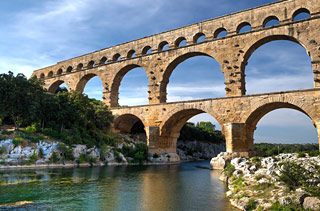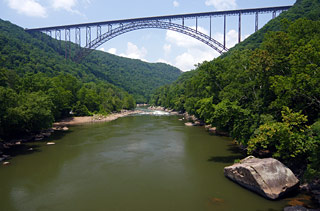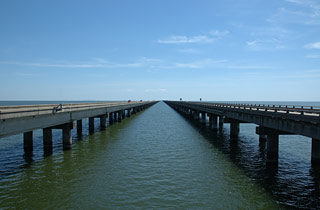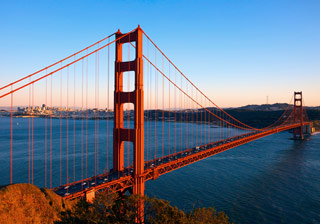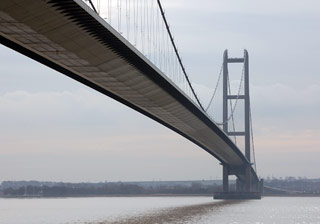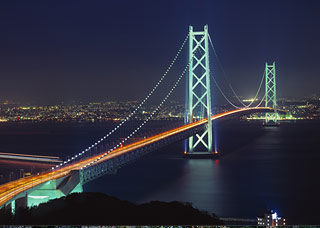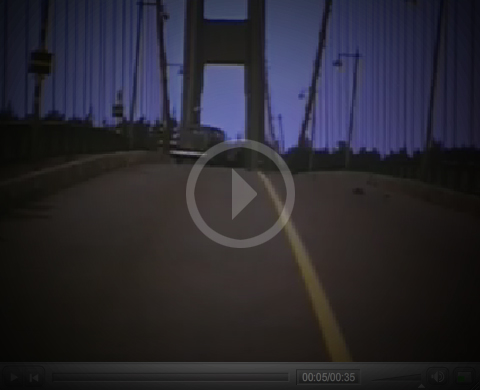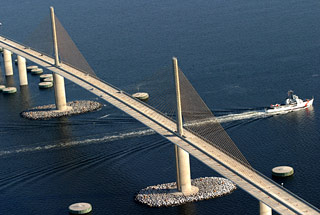Build a Bridge
- by Kate Hudec
- Posted 11.01.97
- NOVA
Do your homework
Now that you’ve looked at the sites, you’ll want to review four basic types of bridges so that you make the right choice for the site. Below, learn more about arch, beam, suspension, and cable-stayed bridges. Watch for “Try It” buttons. These will show you how to do simple things at home or school that show you the forces at work.
Arch Bridge
One of the oldest types of bridges, arch bridges have great natural strength. Instead of pushing straight down, the weight of an arch bridge is carried outward along the curve of the arch to the supports at each end. These supports, called the abutments, carry the load and keep the ends of the bridge from spreading outward.
Try It!
How do the abutments support an arch bridge?
Cut a strip of cardboard that's about one inch by 11 inches. Gently bend the strip so that it has a curve. Position the cardboard on a table so that it resembles an arch. Press down on the center of the arch. What happens to the ends of the cardboard?


Next, place a stack of books at each end of the arch. Press again. Now what happens? Notice how the stacks of books act as abutments, keeping the ends of the arch from spreading outward.
When supporting its own weight and the weight of crossing traffic, every part of the arch is under compression. For this reason, arch bridges must be made of materials that are strong under compression.
The Romans used stones. One of the most famous examples of their handiwork is the Pont du Gard aqueduct near Nîmes, France. Built before the birth of Christ, the bridge is held together by mortar only in its top tier; the stones in the rest of the structure stay together by the sheer force of their own weight.
Today, materials like steel and prestressed concrete (see sidebar at right) have made it possible to build longer and more elegant arches, including a spectacular 1,700-foot span in New River Gorge, West Virginia. (More typically, modern arch bridges span between 200 and 800 feet.)
One of the most revolutionary arch bridges in recent years is the Natchez Trace Parkway Bridge in Franklin, Tennessee, which was opened to traffic in 1994. It's the first American arch bridge to be constructed from segments of precast concrete, a highly economical material. Two graceful arches support the roadway above. Usually arch bridges employ vertical supports called spandrels to distribute the weight of the roadway to the arch below, but the Natchez Trace Parkway Bridge was designed without spandrels to create a more open and aesthetically pleasing appearance. As a result, most of the live load is resting on the crowns of the two arches, which have been slightly flattened to better carry it. Already the winner of many awards, the bridge is expected to influence bridge design for years to come.
Beam Bridge
A beam or "girder" bridge is the simplest and most inexpensive kind of bridge. According to Craig Finley of Finley/McNary Engineering, "they're basically the vanillas of the bridge world."
In its most basic form, a beam bridge consists of a horizontal beam that is supported at each end by piers. The weight of the beam pushes straight down on the piers.
Try It!
What happens when a load pushes down on a beam bridge?

Take a flat eraser or a small sponge and slice a shallow notch across the top and bottom. Create a beam bridge by supporting each end of the eraser or sponge with a stack of books. Press down on the center of the bridge. What happens to the top and bottom notches? Notice how the top notch squeezes together in compression, while the bottom notch spreads apart under tension.
Prestressed concrete (see sidebar at right) is an ideal material for beam bridge construction. The concrete withstands the forces of compression well, and the steel rods embedded within resist the forces of tension. Prestressed concrete also tends to be one of the least expensive materials in construction.
But even the best materials can't compensate for the beam bridge's biggest limitation: its length. The farther apart its supports, the weaker a beam bridge gets. As a result, individual beam-bridge girders rarely stretch more than 250 feet. This doesn't mean beam bridges aren't used to cross great distances; it only means that they must be daisy-chained together, creating what's known in the bridge world as a continuous span.
In fact, the world's longest bridge is a continuous-span beam bridge. Almost 24 miles long, the Lake Pontchartrain Causeway consists of a pair of two-lane sections that run parallel to each other. The Southbound Lane, completed in 1956, comprises 2,243 separate spans, while the Northbound Lane, completed in 1969, includes 1,500 longer spans. Seven crossover lanes connect the two main sections and function as pull-over bays in emergencies. Although impressive, the Lake Pontchartrain Causeway bridge underscores the drawback of continuous spans—they are not well suited for locations that require unobstructed clearance below.
Suspension Bridge
Pleasing to look at, light, and strong, suspension bridges can span distances from 2,000 to 7,000 feet—far longer than any other kind of bridge. They also tend to be the most expensive to build. True to its name, a suspension bridge suspends the roadway from huge main cables, which extend from one end of the bridge to the other. These cables rest atop high towers and are secured at each end by anchorages.
The towers enable engineers to stretch the main cables over long distances. The cables carry most of the bridge’s weight to the anchorages, which are embedded in either solid rock or massive concrete blocks. Inside the anchorages, the cables are spread over a large area to evenly distribute the load and to prevent the cables from breaking free.
Try It!
What are the anchorages for?
Tie two loops of string around the tops of two hardcover books of similar size. Tie a third piece of string to each loop so that it hangs loosely between the books. Press down on the center string. What happens?


Next, stand two books upright about 10 inches apart. Put a stack of heavy books on one end of a string to secure it to the table. Then pass the string over each standing book (letting some string hang loosely between the books). Place a second stack of books on the other end of the string. Press again on the center of the string. What happens? Notice how the anchorages (stacks of books) help to stabilize the bridge.
Some of the earliest suspension-bridge cables were made from twisted grass. In the early 19th century, engineers began using iron chains for such cables. Today, the cables are made of thousands of individual steel wires bound tightly together. Steel, which is very strong under tension, is an ideal material for cables; a single steel wire only 0.1-inch thick can support over half a ton without breaking. Currently, the Humber Bridge in England has the world's longest center span—measuring 4,624 feet.
But this record won't stand for long. In 1998, the Japanese will unveil the $7.6 billion Akashi Kaikyo Bridge, linking the islands of Honshu and Shikoku via Awaji Island. The bridge's center section stretches a staggering 6,527 feet. To keep the structure stable, engineers have added pendulum-like devices on the towers to keep them from swaying and a stabilizing fin beneath the center deck to resist typhoon-strength winds.
Because suspension bridges are light and flexible, wind is always a serious concern—as the residents of Tacoma, Washington can surely attest. At the time it opened for traffic in 1940, the Tacoma Narrows Bridge was the third-longest suspension bridge in the world. It was promptly nicknamed "Galloping Gertie," due to its behavior in wind. Not only did the deck sway sideways, but vertical undulations also appeared in quite moderate winds. Drivers reported that cars ahead of them would completely disappear and reappear from view several times as they crossed the bridge.
Attempts were made to stabilize the structure with cables and hydraulic buffers, but they were unsuccessful. On November 7, 1940, only four months after it opened, the Tacoma Narrows Bridge collapsed in a wind of 42 mph—even though engineers had ostensibly designed the structure to withstand winds of up to 120 mph.
The failure came as a severe shock to the engineering community. Why did a great span, more than half a mile in length and weighing tens of thousands of tons, spring to life in a relatively light wind? And how did slow, steady, and comparatively harmless motions suddenly transmogrify into a catastrophic force?
To answer these questions, engineers began applying the science of aerodynamics to bridge design. Technical experts still disagree on the exact cause of the bridge's destruction, but most agree the collapse had something to do with a complex phenomenon called resonance, the same force that can cause a soprano's voice to shatter a glass.
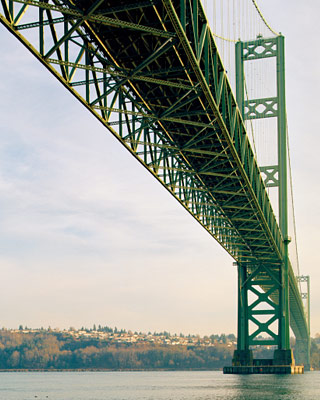
This Tacoma Narrows Bridge opened in 1950, replacing the collapsed "Galloping Gertie." An even newer bridge now stands beside this one. Enlarge Photo credit: © Lawrence Freytag/iStockphoto
Today, wind-tunnel testing of bridge designs is mandatory. As for the Tacoma Narrows Bridge, reconstruction began in 1949. The new bridge is wider, has deep, stiffening trusses under the roadway, and even sports a slender gap down the middle—all to dampen the effect of the wind.
Cable-stayed bridges
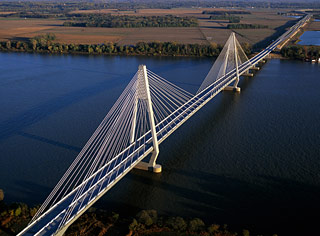
Cable-stayed bridge—William H. Natcher Bridge, Rockport, IN Enlarge Photo credit: © David Sailors/CORBIS
Cable-stayed bridges may look similar to suspension bridges—both have roadways that hang from cables, and both have towers. But the two bridges support the load of the roadway in very different ways. The difference lies in how the cables connect to the towers. In suspension bridges, the cables ride freely across the towers, transmitting the load to the anchorages at either end. In cable-stayed bridges, the cables are attached to the towers, which alone bear the load.
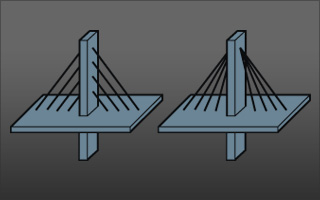
Parallel attachment (left) and radial attachment patterns in cable-stayed bridges Enlarge Photo credit: © WGBH Educational Foundation
The cables can be attached to the roadway in either of two main ways. In a radial pattern, cables extend from several points on the road to a single point at the top of the tower. In a parallel pattern, cables are attached at different heights along the tower, running parallel to one another.
Try It!
How do cable-stayeds work?

Stand up and hold your arms out horizontally at each side. Imagine that your arms are a bridge, and your head is a tower in the middle. In this position, your muscles are holding up your arms.
Try making cable-stayeds to support your arms. Take a piece of rope (about five feet long), and have a partner tie each end of the rope to each of your elbows. Then lay the middle of the rope on top of your head. The rope acts as a cable-stayed and holds your elbows up.
Have your partner tie a second piece of rope (about six feet long) to each wrist. Lay the second rope over your head. You now have two cable-stayeds. Where do you feel a pushing force, or compression? Notice how the cable-stayeds transfer the load of the bridge (your arms) to the tower (your head).
Even though cable-stayed bridges look futuristic, the idea for them goes back a long way. The first known sketch of a cable-stayed bridge appears in a book called Machinae Novae published in 1595, but it wasn't until this century that engineers began to use them. In post-World War II Europe, where steel was scarce, the design was perfect for rebuilding bombed-out bridges that still had standing foundations. Cable-stayed bridges have gone up in the United States only recently, but the response has been passionate.
For medium-length spans—those between 500 and 2,800 feet—cable-stayeds are fast becoming the bridge of choice. And even longer cable-stayeds are going up, though suspension bridges are still used for the very longest spans. Compared to suspension bridges, cable-stayeds require less cable, can be constructed out of identical precast concrete sections, and are faster to build. The result is a cost-effective bridge that is undeniably beautiful.
In 1988, the Sunshine Skyway bridge in Tampa, Florida won the prestigious Presidential Design Award from the National Endowment for the Arts. Painted yellow to contrast with its marine surroundings, the Sunshine Skyway is one of the first cable-stayed bridges to attach cables to the center of its roadway as opposed to the outer edges, allowing commuters an unobstructed view of the magnificent bay. Recently, in Boston, Massachusetts, a cable-stayed design was selected for a new bridge across the Charles River—even though cheaper options were proposed. City officials simply liked the way it looked.
How to Make Prestressed Concrete
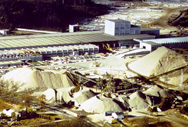 1. It all begins at the prestressed concrete plant.
1. It all begins at the prestressed concrete plant.
 2. This is called a prestressing strand. Made of high-strength steel, it will soon be embedded in concrete.
2. This is called a prestressing strand. Made of high-strength steel, it will soon be embedded in concrete.
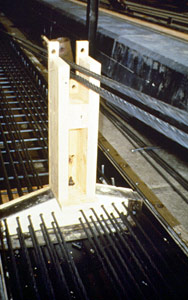 3. The prestressing strand is stretched across the casting bed. About 30,000 pounds of tension will be applied to the cable before it’s encased in concrete. Why? Hold a rubber band loosely between two fingers. Now stretch your fingers farther apart. See how the rubber band becomes taut and more resistant to downward pressure? The same principle holds true for prestressing strands.
3. The prestressing strand is stretched across the casting bed. About 30,000 pounds of tension will be applied to the cable before it’s encased in concrete. Why? Hold a rubber band loosely between two fingers. Now stretch your fingers farther apart. See how the rubber band becomes taut and more resistant to downward pressure? The same principle holds true for prestressing strands.
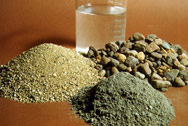 4. Cement, sand, stone, and water make up concrete.
4. Cement, sand, stone, and water make up concrete.
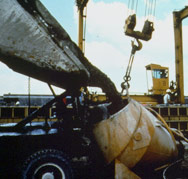 5. Special trucks bring the concrete to the casting bed, where the pouring begins.
5. Special trucks bring the concrete to the casting bed, where the pouring begins.
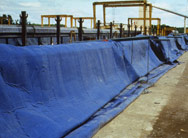 6. Once the pouring is complete, a tarp is placed over the form, and heat is applied to cure the cement.
6. Once the pouring is complete, a tarp is placed over the form, and heat is applied to cure the cement.
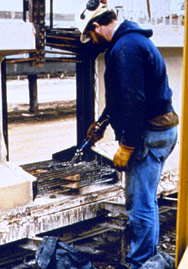 7. The prestressing strands are cut, and the concrete form is removed from the casting bed.
7. The prestressing strands are cut, and the concrete form is removed from the casting bed.
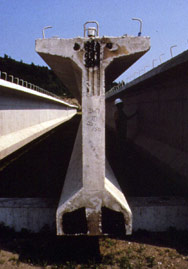 8. The ends are cleaned, and the prestressing strands are sealed with a protective coating.
8. The ends are cleaned, and the prestressing strands are sealed with a protective coating.
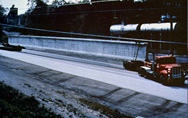 9. The end product is shipped to a building site.
Photo credits: (1-3, 6-9) Rita Seraderian-Precast/Prestressed Concrete Institute; (4-5) Portland Cement Association
9. The end product is shipped to a building site.
Photo credits: (1-3, 6-9) Rita Seraderian-Precast/Prestressed Concrete Institute; (4-5) Portland Cement Association
Sources
Websites
American Society of Civil Engineers A site for engineering professionals with information on publications, job openings, educational programs, conferences, and other industry resources.
Association for Bridge Construction and Design Learn about the activities of this organization devoted to improving the science of bridge design, construction, and maintenance.
Precast/Prestressed Concrete Institute This organization is dedicated to fostering greater understanding and use of precast/prestressed concrete.
The Clark Bridge, Alton Illinois A photo history of the bridge featured in the NOVA program Super Bridge.
Figg Engineering Group, Hanson Professional Services These two companies are the engineers of record for the Clark Bridge.
Golden Gate Bridge Read about the history of the Golden Gate Bridge and take a virtual stroll from the Marin side of the bridge across to San Francisco.
Books
Billington, David P. 1985. The Tower and the Bridge: The New Art of Structural Engineering. Princeton University Press.
Leonhardt, Fritz. 1990. Bridges. MIT Press.
Credits
- Producer:
- Kate Hudec
- Special Thanks:
- Paul Barbone
- Craig Finley
- Marty McIntyre
- Rita Seraderian

